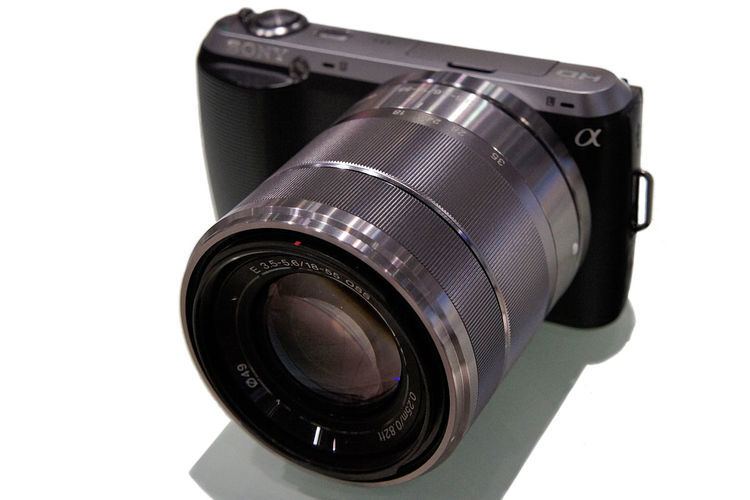 | ||
The E-mount is a lens mount designed by Sony for their NEX ("New E-mount eXperience") and ILCE series of camcorders and mirrorless cameras. The E-mount supplements Sony's A-mount allowing the company to develop more compact imaging devices while maintaining compatiblity with 35mm sensors. E-mount achieves this by:
Contents
- Development overview
- Available bodies
- Third party lens manufacturers
- List of manufacturers of third party lenses
- APS C format E mount lenses with autofocus and electronic aperture
- Full frame E mount lenses autofocus electronic aperture
- Full frame E mount lenses manual focus electronic aperture reporting
- Full frame E mount lenses fully manual no electronics
- APS C E mount lenses fully manual no electronics
- Available adapters
- Adapters with focal reducer
- References
The short flange focal distance prohibits the use of a optical viewfinder as a mirror box mechanism cannot be included in this reduced distance. As such all E-mount cameras use an electronic viewfinder.
Development overview
Initially E-mount was implemented on the Sony α NEX-3 and NEX-5 consumer targeted devices with APS-C sized sensors. E-mount integration into Sony camcorder products was provided with the Sony Handycam NEX-VG10. On 24 August 2011 new products were announced, specifically the NEX-5N as a successor for the NEX-5, and the NEX-7 as a prosumer product, as well as the NEX-VG20 as the successor to the NEX-VG10. The Sony E-mount was brought to the 35 milimeter video camera market with the Sony FS-100.
The first third-party camera to use the E-mount was the Hasselblad Lunar, announced at photokina on 18 September 2012 and released in early 2013.
In September 2013, Sony announced the first model from new ILCE series, the Sony α3000. In October 2013, the first models with full-frame sensor size were released, the Sony α7 and Sony α7R.
Available bodies
Third-party lens manufacturers
On 8 February 2011 Sony announced the release of the specifications for the E-mount lens system allowing for third-party lens makers to create lenses for the NEX cameras without having to pay royalties. The mount specifications have been released to registered parties since April 2011. Getting a license for the specifications requires approval by Sony and the signing of a non-disclosure agreement. The construction of full frame manual focus prime lenses without any electronics is relatively easier and less costly than the construction of electronic full frame autofocus lenses of any kind. Additionally, the E-mount Sony α7 series are the only full frame mirrorless cameras and have more electronic aids for manual focusing than full-frame DSLRs. Both these facts have encouraged lesser known lens companies to construct full frame prime lenses with E-mount. Numerous affordable sharp full-format manual prime lenses with big apertures are available with E-mount. In general, nearly all manual lenses can be attached with adapters to mirrorless cameras. That has boosted the market share of manual lenses.
List of manufacturers of third-party lenses
APS-C format E-mount lenses with autofocus and electronic aperture
Full-frame E-mount lenses (autofocus, electronic aperture)
Full-frame E-mount lenses (manual focus, electronic aperture reporting)
The following lenses have manually actuated apertures but can report the aperture value and focal length for inclusion in Exif data and SteadyShot calculations.
Full-frame E-mount lenses (fully manual, no electronics)
Samyang Optics / Rokinon Macro 100 mm f/2.8 UMC
APS-C E-mount lenses (fully manual, no electronics)
Available adapters
Due to the short flange focal distance of the Sony E-mount, many lenses can be adapted to be used on the Sony E-mount, although a crop factor will have to be taken into account for all cameras with APS-C or Super-35mm sensor format.
Any A-mount lenses can be used via the Sony LA-EA1, LA-EA2, LA-EA3, or LA-EA4 mount adapters which provide electronic contacts and electro-mechanical diaphragm control. They allow the body to control the aperture of the lens and provide automatic exposure and Exif data support. The LA-EA1 and LA-EA3 only able to autofocus motor lenses (SSM and SAM), screw driven lenses can be used with manual focus only. Older samples of the LA-EA1, NEX-3 and NEX-5 require a firmware update for this to work. The LA-EA2 and LA-EA4 adapters support fast phase-detection autofocus with all A-mount lenses (except for the few dedicated manual focus A-mount lenses), including screw-driven AF lenses. However, their translucent-mirror design requires an optical element in the light path and thus causes a light fall-off of about 30% for the autofocus to work. Also, it slightly decreases image quality. The LA-EA1 and LA-EA3 do not need optical elements in the light path and thus will not change image quality in any way. The LA-EA1 and LA-EA2 are designed to cover the APS-C format only, whereas the LA-EA3 and LA-EA4 are full-frame capable (when used on a full-frame camera).
Techart offers unique autofocusing adapter which has motor which moves adapter flange along optical axis. It has Leica M-mount on the lens side, but via stacking additional adapter almost any SLR lens can be mounted.
The following lens mounts can be used on the Sony E-mount with the use of various adapters available from third parties:
Adapters with focal reducer
Focal reducer is a device which inserts between main lens and camera and shrinks image circle while simultaneously increasing f-stop of the lens. The downside is than only lens from other systems with longer flange distance are accepted. Native E-mount lenses are not supported.
